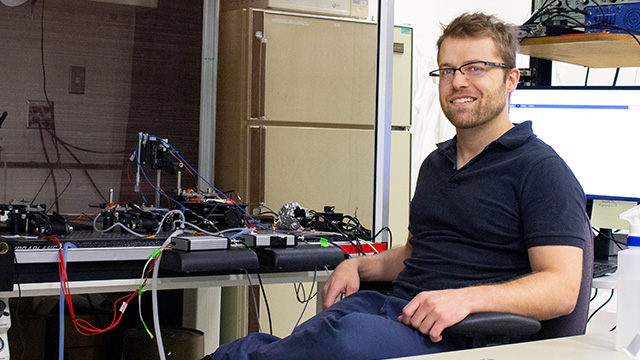
Jesse Jackson and his team of researchers are studying the role of the claustrum in the circuit that regulates emotions, such as anxiety, in the brain.
Last year, the Brain and Behavior Research Foundation (BBRF) received nearly 1,000 applications for Young Investigator grants from the National Alliance for Research on Schizophrenia & Depression (NARSAD) in the areas of basic, translational and clinical mental-health research.
University of Alberta assistant professor of physiology and Neuroscience and Mental Health Institute (NMHI) member Jesse Jackson was one of 200 winners of this prestigious international award, securing $70,000 US over two years for his lab's research on anxiety.
We spoke to Jackson about what the NARSAD award means to his work.
What is the focus of your research?
The amygdala and the prefrontal cortex have long been known to play a role in regulating emotion and anxiety, and my primary interest is how parts of the brain interact and communicate with each other. My team is working to understand the role of a third party-the claustrum-in this circuit.
We know the amygdala is really crucial to emotional processing, and we found that this claustrum region receives a lot of strong inputs from the amygdala. It appears to be a link between the amygdala and the prefrontal cortex.
What are your goals for this research?
Anxiety and related disorders are some of the leading mental-health problems in society.
Often patients with depression or anxiety participate in MRI studies that show how prescription drugs can alter brain activity. Perhaps the data we can provide will allow researchers to make better sense of the clinical data they're seeing in those studies.
This could contribute meaningfully to more effective therapies.
What inspires your interest in this area?
I'm fascinated by the basic biology of the brain and I get a lot of enjoyment out of discovering basic principles through the lenses of learning and memory, anxiety and depression.
We all know someone who has struggled with anxiety or depression, and contributing to a knowledge base that has the potential to ease that suffering is some of the most important work there is.
How will the NARSAD grant contribute to the success of your research?
This is a grant targeted to researchers who are just starting their lab, and I'm about two years into my research here at the U of A.
When you're first starting out, every little bit of funding and recognition helps. A grant like this enables a new lab like mine to hire and retain top-notch trainees. If they do really well, the lab does really well.
Why do you think you were successful in winning this grant?
I applied unsuccessfully several years ago for a NARSAD grant. This time, graduate student Alison Do compiled significant preliminary data to support our team's hypothesis, and the team had also recently published a paper on the topic. I believe both factors played a role in strengthening my application.
NMHI deputy director Ian Winship was also instrumental, providing supporting research materials and guidance. More broadly, NMHI has been an outstanding supporter of my lab and the students involved in my projects. I'm sure my association with the institute-and its close alignment with the explicit mental-health mandate of the BBRF-considerably increased my chances of winning.
What advice would you give to researchers applying for this grant?
Start with a well-formulated, original, feasible idea, and make sure you can explain it clearly and concisely. For the NARSAD application, there's a two-page limit-not exactly the space to go into any level of detail about a project-so I had to focus my pitch on the big picture.
Approach researchers who have been successful in the past and ask if they'd be willing to share their applications. Asking for peer review is also a great idea. More than anything, doing those two things made all the difference in the success of this application.
How did it feel to win?
It was pretty exciting. This is the first international award our lab has received and it's often given to people in clinical departments, rather than basic science departments, so this was a particularly nice nod.